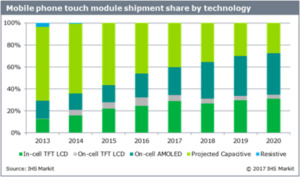 In a blog, David Hsieh of IHS Markit said that embedded (in-cell in LCD, on-cell in OLED) touch has now taken more than 50% of the mobile phone market for the first time and the growth in share of the technology will continue as the premium end of the market moves to AMOLED displays.
In a blog, David Hsieh of IHS Markit said that embedded (in-cell in LCD, on-cell in OLED) touch has now taken more than 50% of the mobile phone market for the first time and the growth in share of the technology will continue as the premium end of the market moves to AMOLED displays.
Apple started to use in-cell touch in the iPhone 5 in 2012 and Samsung switched to on-cell touch for its OLEDs in 2015.
LCD makers have also been successful in persuading notebook makers to adopt the technology to help to reduce the weight and thickness of PCs. IHS said that, overall, the percentage of notebook PCs featuring touch displays compared to non-touch solutions surged in the past year in global shipments, rising from 9.4% in 2015 to 26.0% in 2016. 2-in-1 PCs have also adopted the technology.
Companies that have been supplying touch modules are having to re-align their businesses and are aiming at larger sized display applications such as A-I-O PCs, automotive displays and interactive whiteboards.

